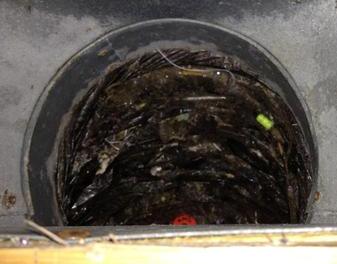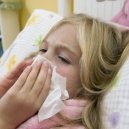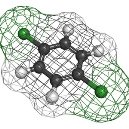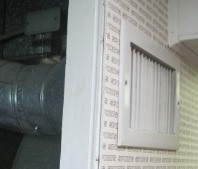Find a pre-screened local mold removal specialist Free Estimate
Find a Mold Specialist Now
Click or Call, Toll-Free 24/7
Air Conditioner Mold
Finding mold in your home is bad news, but finding air conditioner mold is the worse type of bad news. Throughout the hotter months of the year, every time the blower on your air conditioner comes on it is spreading mold spores further along your HVAC ductwork as well as into every room in your home. Health experts agree that exposure to mold can lead to numerous health problems, most directly related to the respiratory system, which can include asthma, runny nose, coughing, dizziness, and other allergic reactions. Air conditioning mold needs to be removed as soon as possible, to protect your health and the health of your loved ones.
This article deals with mold in central AC systems. If you have mold in a window air conditioner unit, follow the link for more information.
Illnesses Related to AC Mold
Mold in your air conditioning system can lead to a wide range of illnesses. All types of mold can trigger allergic reactions in people sensitive to those substances, but some types of mold produce toxic compounds known as mycotoxins. These compounds can lead to serious health issues such as pneumonia and bleeding in the lungs. Mold found anywhere in the home can result in health problems, but when mold is in the air conditioning system, it can be particularly problematic. Microscopic mold spores become airborne when air blows through the ducts and then are dispersed throughout the home, where they can be easily inhaled or develop into new mold colonies. Infants, pregnant women, the elderly, and any persons who have an immune deficiency are most susceptible to mold-related illnesses, but even healthy, young adults can get sick.
Preventing Air Conditioning Mold
Of course you know what they say, an ounce of prevention is worth a pound of cure, and if you can help prevent the development of air conditioner mold in your home’s HVAC system, that would be much better than having to spend the energy and money to have it removed later on down the road. The Air Conditioning Contractors of America (ACCA) states that keeping your air conditioning ducts free of dirt and other debris with seasonal tune ups can reduce the likelihood of mold growth by making sure there is no organic matter in your home’s HVAC ducts on which mold can feed. In addition to organic materials, mold needs water in order to grow. Any condensation that occurs inside air conditioning ducts will provide the little amount of moisture that mold needs to develop, grow, and thrive. There should never be any standing water inside your air conditioning ducts. If you notice any condensation or water in the HVAC ducts, you need to have your system serviced by a certified professional.
Is Air Conditioner Mold Present?
You should periodically check your air conditioning ducts for mold, especially if you have discovered mold growing in other areas of your home. During warmer seasons, when your air conditioner is operating full time, if you notice a musty odor in different areas in your home, but don’t see any mold growth, there could be a mold issue that is located in your HVAC system. When the HVAC blower comes on, odors can be “pushed” through the ductwork and throughout your home. If you’re not sure if there may be mold in your air conditioning ductwork, or how to check for it, you should have a professional mold testing company inspect your system for you. If mold, or conditions that may lead to a mold problem are found, the contractor can recommend solutions that will prevent any future problems.
How Do You Get Rid of Air Conditioning Mold?
While some homeowners prefer to deal with a household mold problem on their own, the Environmental Protection Agency (EPA) recommends calling in a professional if you have air conditioner mold. However, if you do choose to tackle air conditioner mold removal on your own, you can follow these steps.
- Wear personal protection: this includes latex gloves, safety goggles, protective clothing (a tyvek suit with a hood, that also covers your shoes), and a respirator with cartridges with a N-95 rating or a N-95 rated breathing mask.
- Shut down the HVAC system: as you work to remove any mold or dirt, you don’t want the system blower to “suddenly” start blowing air. This will result in possibly contaminating previously unaffected areas of the home.
- Clean all vent covers: use vinegar to wipe both sides of any register and cold air return covers. When finished, allow the surfaces to dry and make sure you dispose of any paper towels or rags you use by sealing them in a heavy-duty plastic bag and placing the bag in a garbage can located outside the home.
- Clean all metal surfaces: use vinegar to clean all surfaces inside the HVAC main unit as much as possible. Then allow at least one hour of drying time before turning the HVAC system back on.
It can be difficult to access all parts of the air conditioning unit and ductwork, but professionals have the required equipment needed to get the job done. This equipment will include air whips and air skippers to dislodge dust, dirt, mold, and other debris. All of this material is then pulled, by vacuum, into collection devices fitted with HEPA (high-efficiency particulate air) filters so that it can be safely removed from your home. These high-powered vacuums are often portable machines that can be brought into your home and attached to your system, or may be truck-mounted, remaining outside the home. Certified professionals know how to do the job correctly, with safely in mind, so that you, your family, and your pets (yes, pets can be affected by mold exposure) aren’t exposed to harmful mold spores during the mold removal and cleaning process.
Getting rid of air conditioner mold is not an easy task to accomplish. Doing it yourself, and doing it wrong, can lead to very serious complications for your home, and the health and well being of you and your family. For your safety, and for the safety of the other family members, we recommend that you follow this link to find experienced mold removal specialists near you that specialize in dealing with air conditioner mold. They can assist you with the removal of mold from other areas of the home, as well, if needed.
Additional Reading:
Mold in HVAC - Additional information on what to do if you have mold in your heating, ventilation and air conditioning systems or duct work.
Return From Air Conditioner Mold To Home Page
Free Home Inspection By A Mold Removal Specialist
Search This Website
Recent Articles
-
See Our 5 Recommended Mold Removal Companies in Covington, KY
Apr 16, 25 12:59 PM
-
See Our 5 Recommended Mold Removal Companies in Wheaton, IL
Jun 20, 24 10:33 AM
-
See Our 5 Recommended Mold Removal Companies in Aberdeen, SD
Oct 08, 21 04:05 PM






